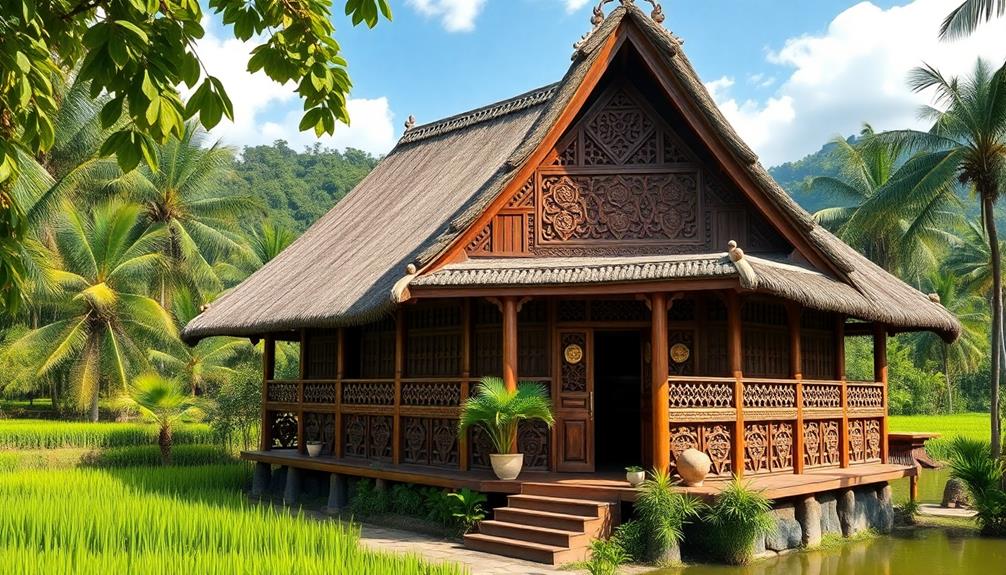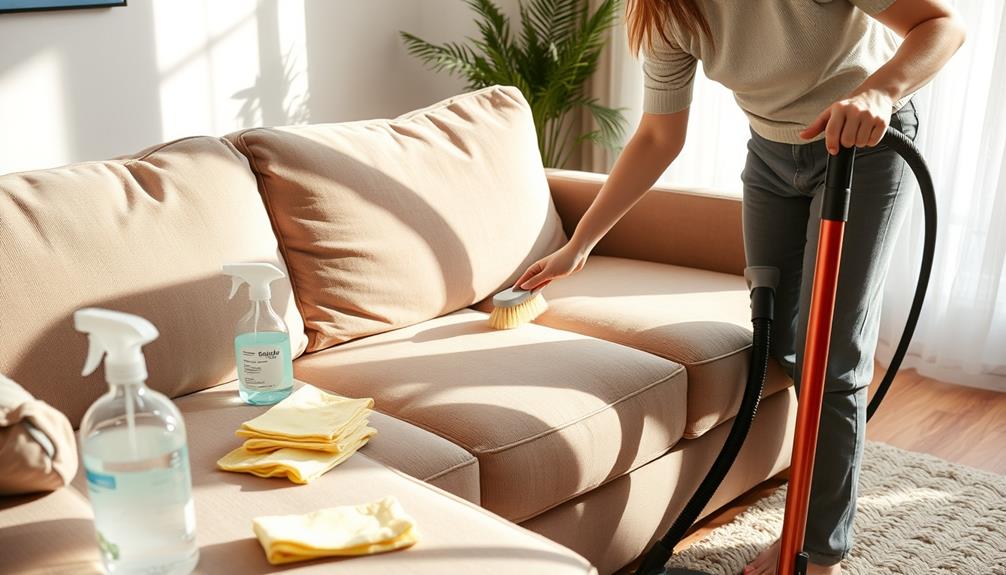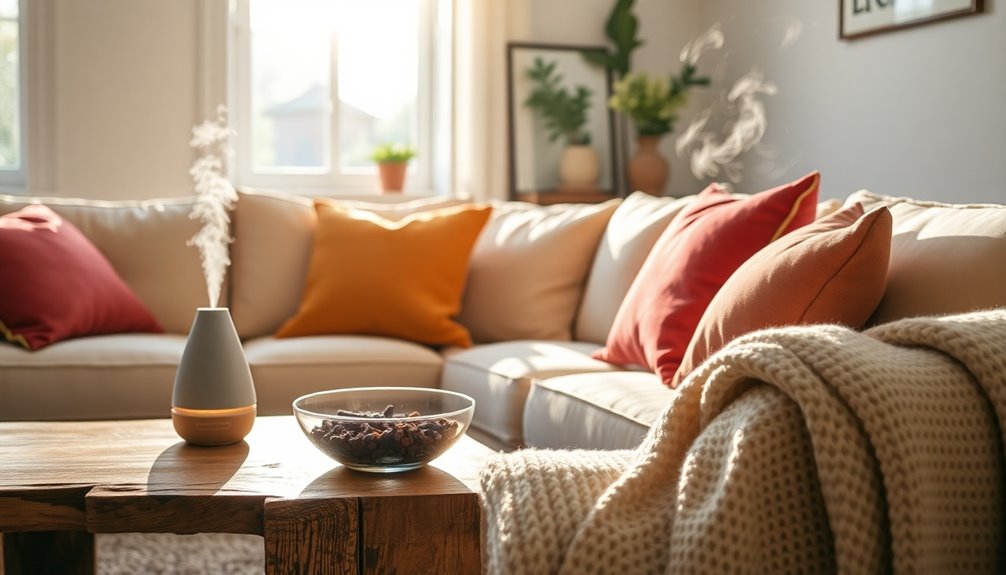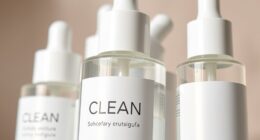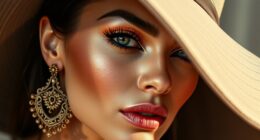A traditional Indonesian house is known as a Rumah Adat, reflecting the diverse ethnic cultures and architectural styles of the country. These houses are built using local materials such as bamboo, wood, and straw, highlighting the community’s craftsmanship and connection to the environment. Each Rumah Adat has its own distinct characteristics, ranging from the buffalo-horned Rumah Gadang in West Sumatra to the boat-shaped Tongkonan in Sulawesi. Raised structures help prevent flooding and pests, while intricate carvings depict local tales. This rich heritage encourages community ties and spiritual beliefs. There is so much more to discover about these captivating homes and their cultural significance!
Key Takeaways
- Traditional Indonesian houses are called "Rumah Adat," reflecting the diverse architectural styles of various ethnic groups.
- Each Rumah Adat embodies cultural heritage, local craftsmanship, and community identity through its unique design and materials.
- Notable examples include Rumah Gadang, Joglo House, and Tongkonan, each representing distinct regional cultures.
- These houses incorporate sustainable materials like bamboo and wood, promoting environmental harmony and traditional craftsmanship.
- Preservation of Rumah Adat is vital for maintaining Indonesia's rich cultural history and attracting tourism.
Meaning of Rumah Adat
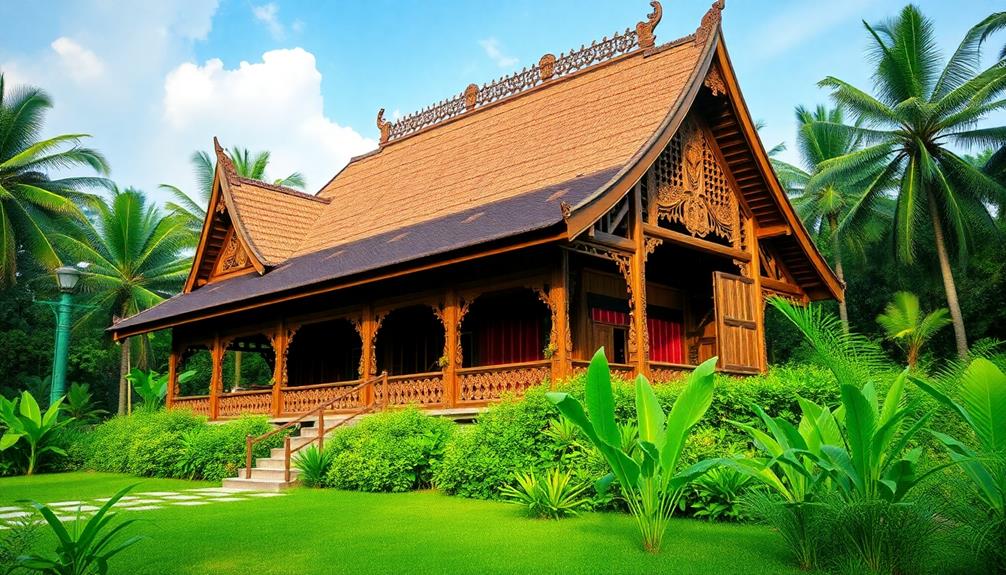
When exploring Indonesia's rich cultural landscape, you'll encounter "Rumah Adat," which are traditional houses that showcase the diverse architectural styles of various ethnic groups across the archipelago.
These homes represent more than just living spaces; they embody the cultural heritage and local culture of their communities. Each Rumah Adat is uniquely designed, often using local materials like bamboo, wood, and straw, which highlights the residents' connection to their environment.
This connection is reflected in how these houses are often elevated to prevent flooding and pests, a practical response to the climate challenges faced in many regions of Indonesia. The distinctive designs often feature symbolic decorations and structural elements that reflect the community's identity, beliefs, and traditions a blend of tradition and modernity.
For instance, you'll notice how the layout and orientation of these houses are influenced by spiritual beliefs, emphasizing the importance of harmony with natural elements.
Additionally, Rumah Adat serves essential social functions; they're not just residences but also communal spaces where rituals, ceremonies, and family gatherings take place.
This aspect underscores the strong social cohesion within the community, making Rumah Adat a significant part of Indonesia's cultural landscape. By appreciating these traditional houses, you gain insight into the intricate tapestry of local culture and the values that shape Indonesian life.
Types of Traditional Houses

Indonesia's traditional houses, known as Rumah Adat, come in a variety of styles that reflect the unique cultures and customs of its many ethnic groups. Each architectural style is often tied to the region's social status and spiritual beliefs, showcasing the rich diversity of Indonesian heritage.
For instance, the Rumah Gadang in West Sumatra features a distinctive buffalo horn-shaped roof and serves as a communal space for family gatherings, recognized as a UNESCO World Heritage site.
In Java, you'll find the Joglo house, which showcases a large open interior and a multi-tiered roof that represents social status, often hosting community events and ceremonies, highlighting Javanese craftsmanship.
Moving to Sulawesi, the Tongkonan houses of the Toraja people stand out with their boat-shaped roofs and elaborate decorations, functioning as both living quarters and ceremonial sites.
If you're exploring Balinese architecture, don't miss the Bale, a traditional pavilion designed for ceremonies. It promotes airflow and connects you with nature, often adorned with intricate carvings.
Finally, the Rumah Betang of the Dayak people in Kalimantan is a longhouse elevated on stilts, embodying communal living and cultural identity through traditional motifs.
Each of these traditional houses tells a unique story of Indonesia's rich cultural heritage, reflecting spiritual elements and cultural symbolism.
Architectural Features
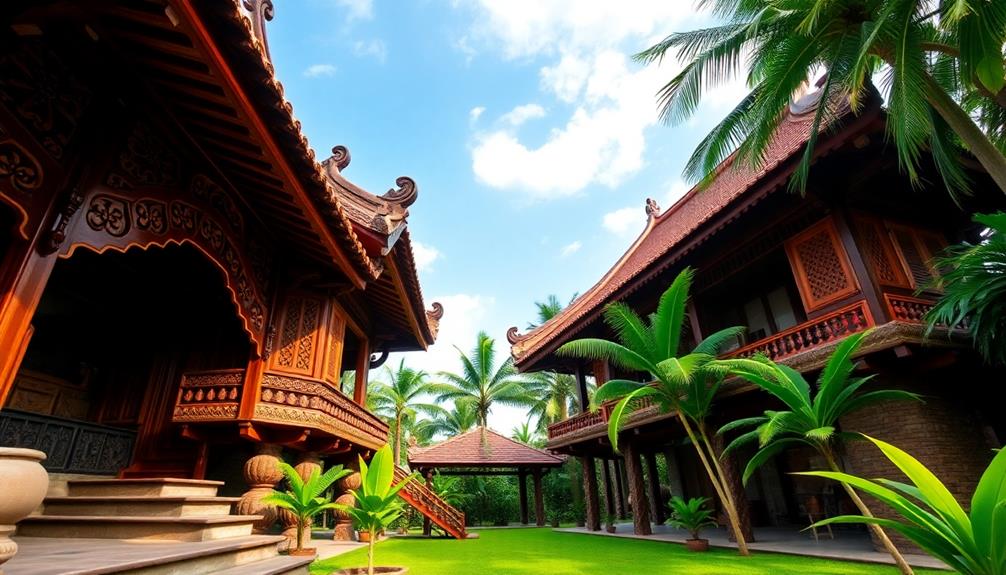
Showcasing a blend of functionality and artistry, traditional Indonesian houses, or Rumah Adat, are characterized by their steeply pitched roofs, often covered with palm leaves or grass to withstand the region's climate.
These vibrant structures not only serve as homes but also embody rich architectural elements that reflect Indonesia's cultural heritage. Additionally, many homes feature unique decorative elements, such as Face Indonesian Decor Masks, which enhance the cultural aesthetic and showcase traditional craftsmanship.
You'll notice several defining features:
- Raised Floors: These elevate the living space, enhancing air circulation and preventing flooding during the rainy season.
- Intricate Carvings: Adorning the wooden beams and walls, these carvings tell stories of local beliefs and customs, adding a personal touch to each home.
- Communal Layouts: Designed for family gatherings and ceremonies, these homes encourage strong communal bonds, fostering a sense of togetherness.
Traditional houses emphasize using sustainable materials like bamboo, wood, and straw, showcasing local craftsmanship.
Each Rumah Adat is more than just a shelter; it's a reflection of the resilience and creativity of the Indonesian people. By understanding these architectural features, you gain a deeper appreciation for the cultural heritage embedded in every traditional house.
Cultural Significance
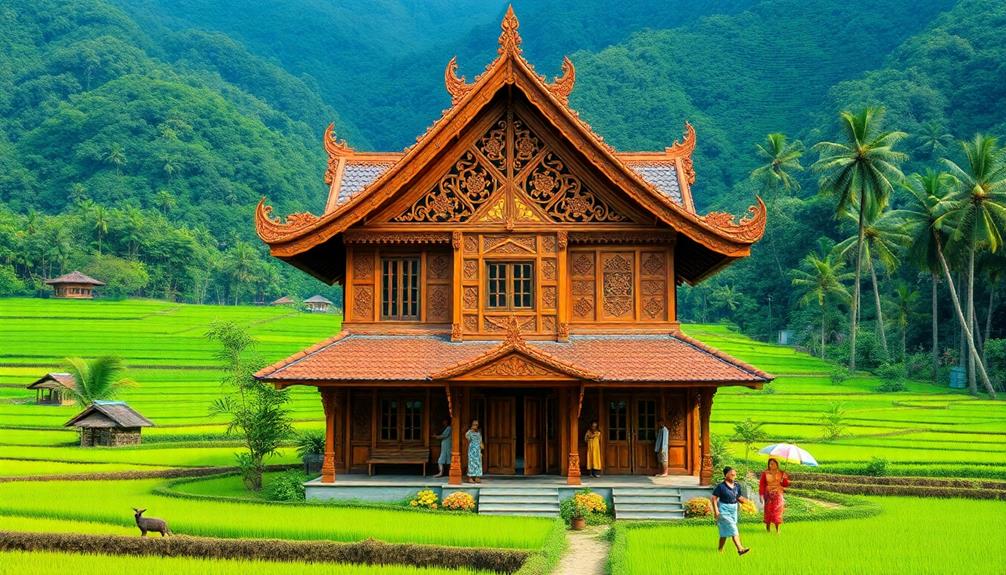
Traditional Indonesian houses, or Rumah Adat, hold deep cultural significance, reflecting the diverse identities of the numerous ethnic groups across the archipelago. These traditional houses embody local customs, architectural styles, and materials, showcasing the unique heritage of each community. They often serve as communal spaces, reinforcing social bonds and family gatherings.
The design of Rumah Adat incorporates spiritual beliefs, with orientations towards sacred sites and symbolic carvings. This connection emphasizes how essential religion is to daily life. Preserving these structures is crucial for maintaining cultural heritage, as they attract tourism and highlight Indonesia's rich history.
Here's a glimpse into the significance of traditional houses:
| Aspect | Description |
|---|---|
| Community Values | Serve as gathering places for families |
| Spiritual Connection | Reflect beliefs through design elements |
| Environmental Harmony | Built with sustainable, local materials |
Regional Variations

While exploring the rich tapestry of Rumah Adat, you'll discover that regional variations reveal the distinct cultural identities of Indonesia's many ethnic groups. Each traditional Indonesian house tells a story, showcasing local craftsmanship and unique beliefs.
For instance, many homes are adorned with vibrant decorative elements, including Indonesian decorative pillows, which bring comfort and cultural heritage into living spaces. Consider these enchanting examples:
- The Toraja people's Tongkonan houses, with their boat-shaped roofs, symbolize the journey to the afterlife, reflecting their deep spiritual beliefs.
- In West Sumatra, the Rumah Gadang stands out with its horn-shaped roof, representing the area's rich cultural heritage and community values.
- Banten's Tagog Anjing features intricate carvings and a pagoda-like roof, embodying the region's artisanal skills and traditions.
These architectural marvels not only serve as homes but also as living museums of cultural heritage.
The Rumah Betang of the Dayak people in Kalimantan, for instance, emphasizes the importance of communal living, accommodating multiple families under one roof.
Each design, from Java's Joglo with its soaring roof to the communal spirit of the Rumah Betang, showcases the diverse influences that shape Indonesia's identity.
Embrace these regional variations, and you'll gain a deeper appreciation for the beauty of traditional Indonesian houses.
Construction Materials

When you look at traditional Indonesian houses, you'll notice they're built using sustainable materials like bamboo, wood, and straw.
This emphasis on natural materials reflects the principles of Balinese interior design, which prioritize eco-friendly resources and craftsmanship techniques passed down through generations.
This blend of nature and skill creates structures that are both functional and beautiful.
Sustainable Material Selection
Sustainable material selection is at the heart of traditional Indonesian house construction, where builders favor locally sourced options that minimize environmental impact.
You'll find that materials like bamboo, coconut timber, and natural stone aren't only beautiful but also environmentally friendly. Additionally, many of these sustainable materials are integral to Tropical Villa Plans that emphasize open spaces and natural light.
Here are three key benefits of these sustainable materials:
- Biodegradable Straw Roofs: Made from palm leaves or grass, they provide natural insulation and protect against rain, enhancing comfort while being eco-conscious.
- Durable Teak Wood: Its natural resistance to pests and weather guarantees long-lasting structures, marrying aesthetic beauty with sustainability.
- Locally Sourced Decorative Elements: Carvings from local hardwoods add cultural significance while promoting the use of abundant, renewable resources.
These choices reflect a commitment to preserving the environment while embracing rich cultural heritage.
Additionally, building techniques like raised floors improve air circulation, reducing the need for artificial cooling.
When you appreciate these sustainable materials, you're not just admiring the craftsmanship; you're also recognizing a deep respect for nature and tradition embedded in every home.
Local Resource Utilization
Many traditional Indonesian houses showcase the clever use of local resources, highlighting the strong connection between culture and environment. With their steeply sloped roofs and open, airy design, traditional Indonesian houses are well-suited to the tropical climate. Yet, many of these houses also incorporate modern amenities, such as plumbing and electricity, demonstrating a harmonious blend of tradition and modernity. This fusion of old and new not only reflects the practical needs of contemporary living, but also serves as a testament to the adaptable nature of Indonesian architectural traditions. In recent years, there has been a resurgence of interest in traditional Indonesian architecture, with many people seeking inspiration from bahay kubo design ideas for their own modern homes. This trend not only emphasizes the timeless appeal of Indonesian housing, but also promotes sustainable building practices and the use of locally sourced materials. By incorporating elements of bahay kubo design, modern homes can pay homage to the rich cultural heritage of Indonesia while also creating environmentally friendly and visually striking living spaces.
You'll notice that these homes are often constructed using natural materials like bamboo, wood, and straw, which are both environmentally friendly and sustainable. For instance, straw roofs made from palm leaves or grass protect against heavy rains, while raised wooden floors allow for natural air circulation.
In addition to these materials, many homes are adorned with traditional artistry that reflects the vibrant culture of Indonesia.
In regions like Bali, you'll find unique materials such as coconut timber and natural stone, combining functionality with aesthetic beauty in architecture. The intricate carvings and vibrant colors you see are more than just decoration; they reflect the local culture and traditions, adding significant cultural heritage to the buildings.
Traditional Craftsmanship Techniques
The craftsmanship techniques used in constructing traditional Indonesian houses reflect a deep understanding of local materials and environmental conditions. By utilizing resources like bamboo, wood, and straw, these houses embody principles of environmental sustainability while showcasing cultural identity.
The emphasis on traditional Indonesian style home decor guarantees that each structure not only serves as a shelter but also as a representation of the local culture. You can feel the connection to the land through the craftsmanship, which emphasizes both durability and beauty.
Here are three key aspects of traditional craftsmanship techniques that resonate deeply with you:
- Natural Materials: The use of locally sourced materials guarantees that the houses blend harmoniously with their surroundings, minimizing environmental impact.
- Elevated Structures: Many homes are built on stilts, protecting against floods and pests while enhancing air circulation and comfort.
- Intricate Designs: Decorative carvings and vibrant colors reflect the unique cultural identity of each ethnic group, celebrating their heritage through craftsmanship.
These techniques not only create functional living spaces but also preserve the rich cultural history of Indonesia. By embracing traditional craftsmanship, you're participating in a legacy that values both the environment and cultural expression.
Preservation Efforts
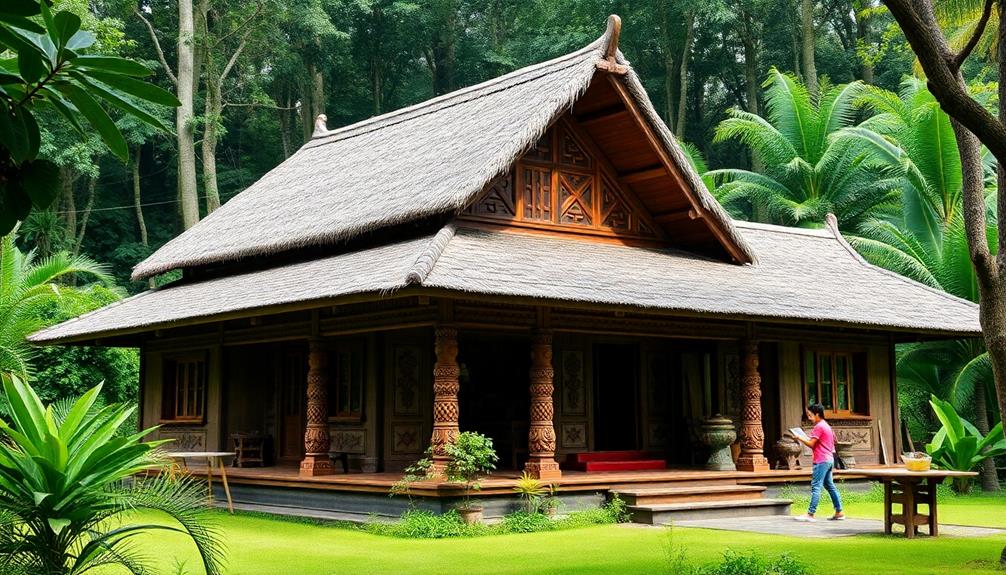
Preservation efforts for traditional Indonesian houses have gained significant momentum in recent years, thanks to various initiatives and legal frameworks. The 2010 amendment to the Law on Protection of Cultural Heritage emphasizes group protection for traditional buildings, fostering awareness and commitment to preserving cultural heritage.
One notable initiative, the Revitalization of Traditional Villages project, targets the restoration of traditional architecture, especially public buildings. This project not only enhances cultural heritage but also supports community identity through tourism, which is linked to economic benefits.
Orobua settlement is a prime example of these efforts, with potential inclusion in Indonesia's World Heritage Tentative List, showcasing the importance of preserving traditional architecture for regional development. Future strategies will focus on community involvement and sustainable tourism, ensuring younger generations engage with and document traditional practices.
Here's a summary of the key preservation efforts:
| Initiative | Focus Area |
|---|---|
| Law on Protection of Cultural Heritage | Group protection for buildings |
| Revitalization of Traditional Villages | Restoration of public structures |
| Orobua Settlement Conservation | Cultural and economic prosperity |
| Future Strategies | Community engagement and tourism |
Modern Influences
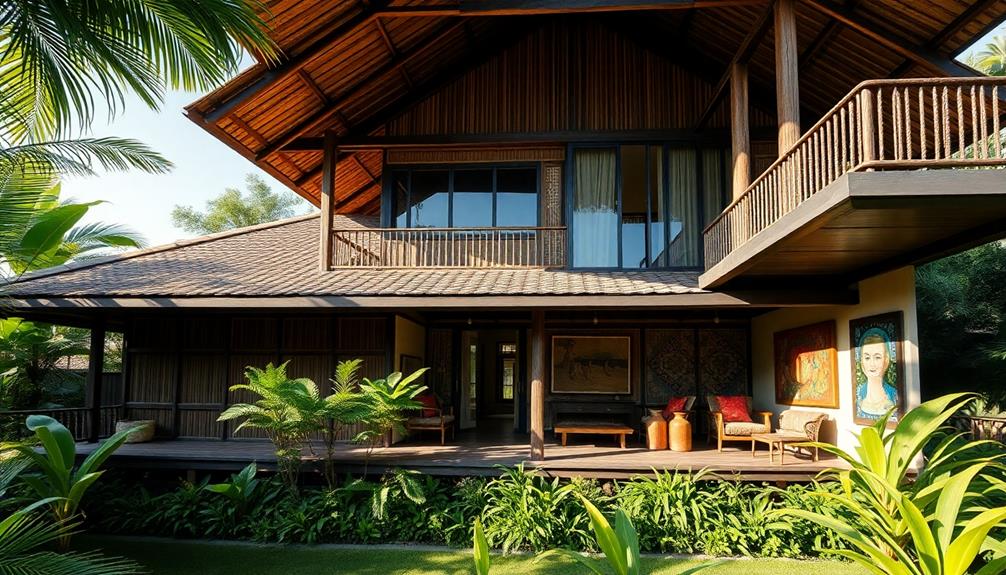
As traditional Indonesian houses face ongoing preservation efforts, modern influences are reshaping their architectural landscape. You might notice how contemporary materials, like tin roofs, are replacing traditional wooden ones, leading to changes that often compromise the original integrity of these cultural treasures.
This shift reflects a broader trend where economic factors and modern living preferences take precedence over preserving cultural heritage. The introduction of vibrant colors and intricate patterns in modern designs can sometimes overshadow the authenticity of traditional motifs, which are celebrated in Indonesian Wedding Decor.
Consider these emotional impacts of modern influences on traditional houses:
- Loss of Identity: As more modern homes emerge, the unique identity of traditional settlements diminishes.
- Cultural Dissonance: The clash between modern materials and traditional architecture may leave you feeling disconnected from your roots.
- Economic Pressures: The choice of lower-cost roofing materials can prioritize convenience over the stories and history embedded in traditional craftsmanship.
Between 2006 and 2020, the increase in modern houses in Orobua illustrates this shift.
Future strategies for preserving traditional architecture emphasize community involvement and sustainable tourism, aiming to maintain cultural identity amidst changing lifestyles.
You can be part of this preservation, ensuring that the beauty and significance of traditional houses endure for generations to come. By supporting restoration efforts and using sustainable materials, you help maintain the integrity and charm that these homes embody. The allure of living in stone homes lies not only in their timeless aesthetic but also in their ability to provide a strong connection to history and craftsmanship. Together, we can safeguard these architectural treasures, allowing future generations to appreciate their enduring splendor.
Frequently Asked Questions
What Is a Traditional House Called in Indonesia?
In Indonesia, traditional houses are called "Rumah Adat." You'll find various styles reflecting local cultures and materials, each unique to its region. These homes serve important roles in community life, showcasing rich cultural heritage.
What Are the Indigenous Houses in Indonesia?
When you explore Indonesia's indigenous houses, you'll find the Rumah Gadang's towering peaks, the Joglo's intricate carvings, and the Tongkonan's graceful roofs. Each structure tells a story of community, tradition, and cultural identity.
What Is a Traditional Balinese House Called?
You'd call a traditional Balinese house a "Bale." It's designed for ceremonies and family gatherings, embodying harmony with nature and spiritual beliefs, featuring unique elements like the Angkul-angkul entrance and Sanggah family shrine.
What Types of Homes Do People Live in Indonesia?
In Indonesia, you'll find diverse homes like the Rumah Adat, each reflecting unique cultural identities. From the ornate Joglo to the boat-shaped Tongkonan, these houses embody the rich heritage and traditions of their respective communities.
Conclusion
To summarize, exploring the world of Rumah Adat reveals Indonesia's rich cultural heritage and diversity. Each traditional house tells a story, reflecting the unique customs and beliefs of its region. As you wander through these architectural marvels, think of the vibrant histories they hold—almost like stepping into a time machine! By appreciating and preserving these structures, we guarantee that future generations can connect with their roots and keep the spirit of Indonesia alive.
